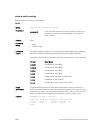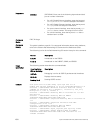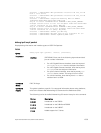Valid values: 0 (key is not encrypted) or 7 (key is encrypted).
key
Text string used in authentication.
For MD5 authentication, the key must be 32 hex digits (non-
encrypted) or 64 hex digits (encrypted).
For SHA-1 authentication, the key must be 40 hex digits
(non-encrypted) or 80 hex digits (encrypted).
null
Causes an encryption policy configured for the area to not
be inherited on the interface.
Defaults Not configured.
Command
Modes
ROUTER OSPFv3
Command
History
This guide is platform-specific. For command information about other platforms,
refer to the relevant Dell Networking OS Command Line Reference Guide.
The following is a list of the Dell Networking OS version history for this command.
Version Description
9.2(1.0) Introduced on the Z9500.
9.1.(0.0) Introduced on the S4810 and Z9000.
8.4.2.0 Introduced on the E-Series TeraScale.
8.3.19.0 Introduced on the S4820T.
Usage
Information
Before you enable IPsec encryption on an OSPFv3 interface, first enable OSPFv3
globally on the router. Configure the same encryption policy (same SPI and keys)
on each interface in an OSPFv3 link.
An SPI value must be unique to one IPsec security policy (authentication or
encryption) on the router.
When you configure encryption for an OSPFv3 area with the area encryption
command, you enable both IPsec encryption and authentication. However, when
you enable authentication on an area with the area authentication command,
you do not enable encryption at the same time.
If you have enabled IPsec authentication in an OSPFv3 area with the area
authentication command, you cannot use the area encryption command in
the area at the same time.
The configuration of IPsec encryption on an interface-level takes precedence over
an area-level configuration. If you remove an interface configuration, an area
encryption policy that has been configured is applied to the interface.
1336
Open Shortest Path First (OSPFv2 and OSPFv3)


















